Multi-paragraph Essays
Objectives:
1) To make a clear argument in writing.
2) To think critically and analytically about a topic.
3) To organize your writing into a clear and thoughtful essay.
Parts of an Essay
How many parts in a Multi-paragraph essay?
What are they?
Introduction
- Body Paragraphs (at least 2-3)
An introductory paragraph has…
- Attention Getter: It could be a quote, a definition, a comment, a question, or a statement that gets the reader’s attention .
Att. Getter continued…
*It always comes first in the essay.
*It should be a general statement. In other words, don’t give specific information away too soon in the essay- focus on the “big” idea first.
Example: Topic- Who is your hero and why?
Thesis: My hero is Martin Luther King, Jr.
Att. Getter: Superman. Wonder Woman. Spiderman. These are all famous superheroes, but the real heroes walk amongst us every day.
- Write att. getters for the following topics:
- Your feelings about starting high school.
- The most impactful event in your life to this point.
- Note: One of these att. getters can not be a question!!
What else is in the introductory paragraph that follows the att. getter?
- The Thesis Statement:
- * The main point of the essay.
- * The point or purpose of the essay is to prove this statement.
- *S hould be an opinion, not a fact. In other words, it could be argued.
- *S tated as if it is a fact .
- No “I think...” or “I believe...”, etc.
What are good examples of thesis statements?
Topic: The advancement of technology in our society.
- Thesis : “The advancement of t echnology has had a positive effect on our society.”
- Create a thesis statement for the topic you chose earlier (high school or event).
- Transition Sentences:
- 1-3 sentences that take us from the attention getter to the thesis.
- Can help “explain” or elaborate on the attention getter. Goes into more detail about the atte ntion getter.
- Gradually become more specific, leading us to the most specific sentence: the thesis.
- Attention Getter: Superman. Wonder Woman. Spiderman. These are all famous superheroes, but the real heroes walk amongst us every day.
- Transition Sentences: Firefighters, paramedics, teachers, and doctors are just a few real-life heroes. They help and serve people every single day.
- Thesis: My hero is also someone who served others and his name was Martin Luther King, Jr.
- Create transition sentences that connect your attention getter to your thesis.
- Don’t forget about using transition words when it applies.
A Plan of Coherence is:
- Always written as the last sentence in the introductory paragraph
- This last sentence has three or more parts listed in a series like “a, b, and c.”
- This offers at least 3 main ideas that will be covered in the body paragraphs. All points should help support the thesis.
- Create a POC for the paragraph in progress.
Homework: Due Tuesday, September 15 (15 points)
- Using one of the following 4 topics, write a complete introduction paragraph. DO NOT WRITE AN ENTIRE MULTI-PARAGRAPH ESSAY!!
- Topics to choose from: 1) school cliques 2) technology in the schools 3) year-round school 4) your favorite school subject
- It should include att. getter, transition sentences, thesis statement, and POC.
- Please type , double space, and print the paragraph.
Body Paragraphs:
- Body paragraphs supply the supporting information for your thesis.
- You should have at least 3 body paragraphs, which correspond to the main ideas in your POC.
- Each body paragraph will consist of a topic sentence, supporting details, and a concluding sentence.
Topic Sentences:
*Introduces the main idea of the paragraph. This refers to the 1st reason in your POC.
Thesis: One of the most impactful events in my life was the decision to attend Gustavus Adolphus College after high school.
Topic Sentence Example: One of the reasons my college choice was such an impactful event in my life is because I was able to play college athletics.
*On your outline, write the t opic sentence for your first body paragraph. Refer to your first point in your POC for this.
*After your topic sentence, you should supply details and explanation for that particular reason.
Detail #1 : Playing a sport in college allowed me to meet so many new people and lifelong friends. I will always cherish those friendships and had I not been a part of a team in college, I may never have formed these relationships.
Detail #2: Playing college tennis also taught me to learn so much about the game, which has allowed me to continue playing and coaching long after I graduated from college. Tennis has become a major part of my life.
Add 2 details to your outline.
Concluding Sentence:
*Each body paragraph should come to a natural close, so you don’t leave the reader hanging. It can refer back to the topic sentence as well.
Example: In conclusion, my college decision impacted me greatly because had I made a different choice, I would not have been able to experience the joy of playing college athletics.
*Add a concluding sentence to your outline.
Conclusion Paragraph Outline:
1) Use a transition word or phrase (In conclusion, etc.) and then r estate your thesis in different words.
2) Review your main reasons you stated in the body paragraphs. 1-2 sentences
3) Clincher statement- this could be a restatement of your attention getter in different words.
Example Conclusion:
Making the decision to go to Gustavus Adolphus College was such an impactful decision for me. (restatement of the thesis) I was able to meet so many great friends, expand my knowledge of the sport and take those skills with me throughout the rest of my life. (review of main reasons from body paragraphs) Our lives are full of impactful and meaningful events, which help to shape us. Acknowledging those events is an important step in living a fulfilling life. (clincher statement)

Microsoft 365 Life Hacks > Writing > How to Write a Five Paragraph Essay

How to Write a Five Paragraph Essay
A classic five paragraph essay is an easy way to convey a belief or statement, back it up with some supporting points and evidence, and tie it all up with a conclusion. Read on to see this format in action and learn how to write a five paragraph essay.

The format begins with an introductory paragraph that contains a thesis statement that is the basis for the entire essay and gets your reader’s attention. The introduction develops the ideas of what you will cover with at least three statements that support that thesis. Each of those three statements is fleshed out with its own paragraph to provide further support. While many essays are longer and more involved, a five paragraph essay is a great tool for those who are learning how to write and back up their points. It encourages organization, research, and planning. The five paragraph essay is a fantastic way to organize your thoughts and convey a point.

Write like a pro with Microsoft Editor
Improve your spelling and grammar anywhere you write.
The body of your five paragraph essay begins with a section that addresses the first point you made in your introduction that backed up your thesis. If your essay is based on opinion, you’ll want to make sure that your points are clear and concise. On the other hand, if you are creating an essay that requires citations and facts, make sure that you do your research. This type of essay can be incredibly persuasive if well written, and having your claims backed up with clear points and strong research can help to sway your audience. Use specific details, demonstrated though closely related examples and evidence, to make your case.
Another important point while writing your five paragraph essay is that it is a great tool for learning. This format is primarily used to teach younger children how to organize their thoughts and present facts and opinions, but that does not diminish its value as a writing tool. No matter how old you are or what you’re writing, being able to lean on this format can help you put your thoughts together. Start with an introduction that hooks the reader, make your points and back each one up with its own paragraph, and then round it all out with a conclusion. Use transition language like, “next” and “finally” between your supporting paragraphs to indicate that you’re moving to a new point. A basic five paragraph essay outline will help you even if you’re writing a longer essay or paper.
Finally, your last supporting paragraph should touch on the third point you made in your introduction. In the case of this post, that point referred to organization, research, and planning. Before you truly begin to write your five paragraph essay, take the time to organize your thoughts. Jot down your ideas and find which points best back up your thesis and organize them so that they flow smoothly and make sense to your reader. This type of outline helps with all kinds of writing because it helps to establish good writing habits. You’ll group similar thoughts together so that your writing is cohesive, and you’ll reinforce statements with facts, lending credibility. Whether you’re putting together your doctoral thesis or defending your opinion about ice cream flavors, being able to plan your essay will help you write clearly.
The final paragraph of your essay should wrap everything up and solidify your thesis. This concluding paragraph should revisit your original topic and invite your reader to consider why it’s significant. The five paragraph essay is an incredible tool for making and supporting a point and is helpful for writers of any age or skill level. Being able to master this format will help you present your thoughts and ideas clearly, even if you’re not writing, because you’ve trained your brain to organize information effectively. In addition to being helpful with schoolwork, this format is great for helping you become a better writer . Take the time to get your thoughts in order before you put pen to paper, and the final product is sure to be great.
Get started with Microsoft 365
It’s the Office you know, plus the tools to help you work better together, so you can get more done—anytime, anywhere.
Topics in this article
More articles like this one.

What is independent publishing?
Avoid the hassle of shopping your book around to publishing houses. Publish your book independently and understand the benefits it provides for your as an author.

What are literary tropes?
Engage your audience with literary tropes. Learn about different types of literary tropes, like metaphors and oxymorons, to elevate your writing.

What are genre tropes?
Your favorite genres are filled with unifying tropes that can define them or are meant to be subverted.

What is literary fiction?
Define literary fiction and learn what sets it apart from genre fiction.

Everything you need to achieve more in less time
Get powerful productivity and security apps with Microsoft 365

Explore Other Categories
The Ultimate Guide to the 5-Paragraph Essay
PeopleImages / Getty Images
- M.Ed., Education Administration, University of Georgia
- B.A., History, Armstrong State University
A five-paragraph essay is a prose composition that follows a prescribed format of an introductory paragraph, three body paragraphs, and a concluding paragraph, and is typically taught during primary English education and applied on standardized testing throughout schooling.
Learning to write a high-quality five-paragraph essay is an essential skill for students in early English classes as it allows them to express certain ideas, claims, or concepts in an organized manner, complete with evidence that supports each of these notions. Later, though, students may decide to stray from the standard five-paragraph format and venture into writing an exploratory essay instead.
Still, teaching students to organize essays into the five-paragraph format is an easy way to introduce them to writing literary criticism, which will be tested time and again throughout their primary, secondary, and further education.
Writing a Good Introduction
The introduction is the first paragraph in your essay, and it should accomplish a few specific goals: capture the reader's interest, introduce the topic, and make a claim or express an opinion in a thesis statement.
It's a good idea to start your essay with a hook (fascinating statement) to pique the reader's interest, though this can also be accomplished by using descriptive words, an anecdote, an intriguing question, or an interesting fact. Students can practice with creative writing prompts to get some ideas for interesting ways to start an essay.
The next few sentences should explain your first statement, and prepare the reader for your thesis statement, which is typically the last sentence in the introduction. Your thesis sentence should provide your specific assertion and convey a clear point of view, which is typically divided into three distinct arguments that support this assertation, which will each serve as central themes for the body paragraphs.
Writing Body Paragraphs
The body of the essay will include three body paragraphs in a five-paragraph essay format, each limited to one main idea that supports your thesis.
To correctly write each of these three body paragraphs, you should state your supporting idea, your topic sentence, then back it up with two or three sentences of evidence. Use examples that validate the claim before concluding the paragraph and using transition words to lead to the paragraph that follows — meaning that all of your body paragraphs should follow the pattern of "statement, supporting ideas, transition statement."
Words to use as you transition from one paragraph to another include: moreover, in fact, on the whole, furthermore, as a result, simply put, for this reason, similarly, likewise, it follows that, naturally, by comparison, surely, and yet.
Writing a Conclusion
The final paragraph will summarize your main points and re-assert your main claim (from your thesis sentence). It should point out your main points, but should not repeat specific examples, and should, as always, leave a lasting impression on the reader.
The first sentence of the conclusion, therefore, should be used to restate the supporting claims argued in the body paragraphs as they relate to the thesis statement, then the next few sentences should be used to explain how the essay's main points can lead outward, perhaps to further thought on the topic. Ending the conclusion with a question, anecdote, or final pondering is a great way to leave a lasting impact.
Once you complete the first draft of your essay, it's a good idea to re-visit the thesis statement in your first paragraph. Read your essay to see if it flows well, and you might find that the supporting paragraphs are strong, but they don't address the exact focus of your thesis. Simply re-write your thesis sentence to fit your body and summary more exactly, and adjust the conclusion to wrap it all up nicely.
Practice Writing a Five-Paragraph Essay
Students can use the following steps to write a standard essay on any given topic. First, choose a topic, or ask your students to choose their topic, then allow them to form a basic five-paragraph by following these steps:
- Decide on your basic thesis , your idea of a topic to discuss.
- Decide on three pieces of supporting evidence you will use to prove your thesis.
- Write an introductory paragraph, including your thesis and evidence (in order of strength).
- Write your first body paragraph, starting with restating your thesis and focusing on your first piece of supporting evidence.
- End your first paragraph with a transitional sentence that leads to the next body paragraph.
- Write paragraph two of the body focussing on your second piece of evidence. Once again make the connection between your thesis and this piece of evidence.
- End your second paragraph with a transitional sentence that leads to paragraph number three.
- Repeat step 6 using your third piece of evidence.
- Begin your concluding paragraph by restating your thesis. Include the three points you've used to prove your thesis.
- End with a punch, a question, an anecdote, or an entertaining thought that will stay with the reader.
Once a student can master these 10 simple steps, writing a basic five-paragraph essay will be a piece of cake, so long as the student does so correctly and includes enough supporting information in each paragraph that all relate to the same centralized main idea, the thesis of the essay.
Limitations of the Five-Paragraph Essay
The five-paragraph essay is merely a starting point for students hoping to express their ideas in academic writing; there are some other forms and styles of writing that students should use to express their vocabulary in the written form.
According to Tory Young's "Studying English Literature: A Practical Guide":
"Although school students in the U.S. are examined on their ability to write a five-paragraph essay , its raison d'être is purportedly to give practice in basic writing skills that will lead to future success in more varied forms. Detractors feel, however, that writing to rule in this way is more likely to discourage imaginative writing and thinking than enable it. . . . The five-paragraph essay is less aware of its audience and sets out only to present information, an account or a kind of story rather than explicitly to persuade the reader."
Students should instead be asked to write other forms, such as journal entries, blog posts, reviews of goods or services, multi-paragraph research papers, and freeform expository writing around a central theme. Although five-paragraph essays are the golden rule when writing for standardized tests, experimentation with expression should be encouraged throughout primary schooling to bolster students' abilities to utilize the English language fully.
- How To Write an Essay
- How to Write a Great Essay for the TOEFL or TOEIC
- Write an Attention-Grabbing Opening Sentence for an Essay
- How to Write and Format an MBA Essay
- How to Structure an Essay
- How to Help Your 4th Grader Write a Biography
- Definition and Examples of Body Paragraphs in Composition
- What Is Expository Writing?
- What an Essay Is and How to Write One
- Paragraph Writing
- 3 Changes That Will Take Your Essay From Good To Great
- An Introduction to Academic Writing
- Tips on How to Write an Argumentative Essay
- The Five Steps of Writing an Essay
- How to Write a Solid Thesis Statement
- The Introductory Paragraph: Start Your Paper Off Right


4.2 THE BIG PICTURE: Moving Beyond the Five-Paragraph Essay

The skills that go into a very basic kind of essay — often called the five-paragraph essay — are indispensable. If you’re good at the five-paragraph theme, then you’re good at identifying a clear thesis, arranging cohesive paragraphs, organizing evidence for key points, and connecting your main idea to the world through the introduction and conclusion.
In college, you need to build on those essential skills. The five-paragraph essay by itself is bland and formulaic. In other words, it is not very interesting to read, and it doesn’t feel very natural. More importantly, it doesn’t get you (or your reader) to think very deeply. Your professors are looking for a more ambitious, arguable, and compelling thesis with real-life evidence for all key points — all in a more organic (less artificial) structure.
What does that look like?
The five-paragraph essay, outlined below in Figure 3.1 is probably what you’re used to: the introduction starts general and gradually narrows to a thesis, which readers expect to find at the very end of that paragraph. In this format, the thesis uses that magic number of three: three reasons why a statement is true. Each of those reasons is explained and justified in the three body paragraphs, and then the conclusion restates the thesis before gradually getting broader. This format is easy for readers to follow, and it helps writers to organize their points and the evidence that goes with them. That’s why you learned this format.

Figure 3.1 The traditional five-paragraph essay structure
Figure 3.2, in contrast, represents a paper on the same topic that has the more organic form that is expected in college. The first key difference is the thesis. Rather than simply presenting a number of reasons to think that something is true, it puts forward an arguable statement: one with which a reasonable person might disagree. An arguable thesis gives the paper purpose. It surprises readers and draws them in. You hope your reader thinks, “Hm. Why would they come to that conclusion?” and then feels compelled to read on.
The body paragraphs, then, build on one another to carry out this ambitious argument. In the classic five-paragraph essay (Figure 3.1), it probably is not important which of the three reasons you explain first or second. In the more organic structure (Figure 3.2), each paragraph specifically leads to the next. If you changed the order of the body paragraphs, then the essay would not make sense.
The last key difference is seen in the conclusion. Because the organic essay has a thesis that does not have an obvious conclusion, the reader comes to the end of the essay thinking, “OK, I’m convinced by the argument. What do you, the author, make of it? Why does it matter?” The conclusion of an organically structured paper has a real job to do. It doesn’t just reiterate the thesis; it explains why the thesis matters.

Figure 3.2 The organic research essay structure
All that time you spent mastering the five-paragraph form in Figure 3.1 was not wasted. There’s an idiom in English: You have to know the rules before you can break the rules. But now is the time to move beyond an obvious thesis, loosely related body paragraphs, and a repetitive conclusion. Now is the time for you to move beyond the five-paragraph essay.
Watch this video to learn more about moving beyond the five-paragraph essay to an organic research essay:
Now practice with this exercise; it is not graded, and you may repeat it as many times as you wish:
Text adapted from: Guptill, Amy. Writing in College: From Competence to Excellence . 2022. Open SUNY Textbooks, 2016, milneopentextbooks.org/writing-in-college-from-competence-to-excellence/ . Accessed 16 Jan. 2022. CC BY-NC-SA
Video from: The Nature of Writing. “What’s Wrong with the Five Paragraph Essay and How to Write Organically (Animated Video).” Www.youtube.com, 3 Sept. 2019, www.youtube.com/watch?v=ZAlcAGVBEXU. Accessed 30 Dec. 2021.
Synthesis Copyright © 2022 by Timothy Krause is licensed under a Creative Commons Attribution-NonCommercial-ShareAlike 4.0 International License , except where otherwise noted.
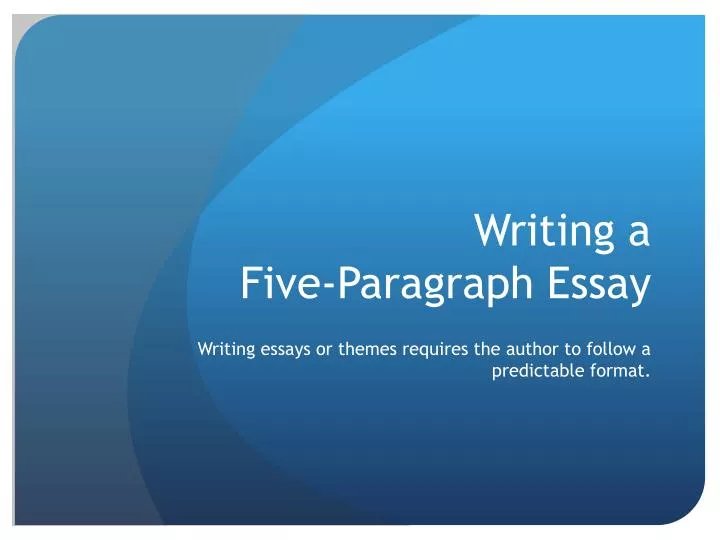
Writing a Five-Paragraph Essay
Jul 20, 2014
320 likes | 605 Views
Writing a Five-Paragraph Essay.
Share Presentation
- renaissance italy
- paragraph essay
- rough draft sentences
- working essay
- important details

Presentation Transcript
Writing aFive-Paragraph Essay Writing essays or themes requires the author to follow a predictable format.
The Completed Essay • Four identifiable parts • Title • Introductory Paragraph • Body or Detail Paragraphs (3+) • Concluding Paragraph
The Working Essay • The author will be similar to a chef creating a delicious Italian grinder. • First – find the recipe and gather ingredients (brainstorming and pre-writing) • Second – create the filling (the body paragraphs) • Third – prepare the bun (intro and conclusion) • Lastly – garnish the dish (title)
1a. The Recipe • Find the topic = Renaissance • Narrow the topic = People places, inventions, and ideas helped make the Renaissance flourish in the countries of Western Europe.
1b. The Ingredients • Through outlining or webbing, the organization of the essay is found. • In our case, the graphic organizers or webs made of five European countries will be used. Your job will be to choose three of the five countries we studied.
One Secret Ingredient • To receive a grade of an “A” • For each of the three countries chosen, students must research a new person, invention, or idea that has not been mentioned in the textbook. • Add this new addition to the graphic organizer IN RED INK. • Be sure to add the important details about this person to the graphic organizer. • Use movie notes or Google. Be sure the dates match the Renaissance period. (roughly from 1300 – 1600)
2. Let the writing begin. • Excellent essays are written by authors who understand writing is powerful when written OUT OF ORDER. • Most authors of excellent essays write the body paragraphs first, then the introduction, then the conclusion, and finally the title. • These parts are rearranged for the final essay
One Word of Caution • Authors who write with knowledge and maturity tell facts and information. They NEVER tell strategy! • How do you reveal strategy? • In this essay, I will write about…. • In this paragraph you will read about… • This essay / paragraph is about… • The most immature writing example: I hope you enjoyed my essay about the Renaissance. / Thank you for reading my … / Now you know about… / • The words “I, me, or my” should not be used in this essay!
2. Body paragraph #1 • What country would be a good place to start? • Now look at your web and decide what people, inventions, or ideas need to be included in this paragraph. Star them on your graphic organizer. You want to choose three or four strong examples that help the Renaissance to flourish in this country. • Remember the secret ingredient in your three or four choices.
2. Body Paragraph #1 has three parts. • Topic sentence • Detail sentences • Clincher sentence
2. The topic sentence • Is usually the first sentence • Introduces the main idea • Sometimes introduces the details
2. Types of topic sentences • General topic sentence • Clueing topic sentence • Specific topic sentence
2. General Topic Sentence • Names the main idea of the paragraph in an interesting way • Example: The Renaissance flourished in Italy which is where the Renaissance began.
2. Clueing Topic Sentence • Names the main idea • Gives a clue about the details • Examples: • The Renaissance flourished in Italy because of several people. • The Renaissance flourished in Italy thanks to the contributions of three people. • The Renaissance, which began in Italy, was deeply influenced by the work of artists and architects.
2. Specific Topic Sentence • Names the main idea • Names the specific details to be covered in order • Example: The Renaissance flourished in Italy thanks to the artist Leonardo de Vinci, the artist Michelangelo, and the architect Filippo Brunelleschi.
Write • Choose what type of topic sentence you want for this first body paragraph, and write it. • Remember this sentence is the first in the paragraph so it will be indented. The detail sentences and the clincher will also be part of this first body paragraph.
2. Detail Sentences • Name 1-3 main ideas • Should give reader interesting information about the details • Should contain related info. • Be in logical order • Includes transition words if new detail
2. Transitions • One example / Another example / A further example / • For example / For instance / Still another / In addition / Additionally / • One / Another / A further / The last • First / Second / Third / Last
2. Detail sentences • Lead off • Leads into a new detail • Contains a transition • Follow-up • Provides more info. about the detail
Write • Add on to the topic sentence you wrote for this paragraph by adding on the three or four details.
2. Clincher Sentence • Last sentence in the paragraph • Closes the paragraph • Renames the main idea of the paragraph • Sometimes summarizes or names the details • Different from the topic sentence • May use concluding transition words that tell the reader the paragraph is finished
2. General Clincher Sentence • Only summarizes the main idea • Example: As you can see, some of the most famous people of history were found in Renaissance Italy.
2.Clueing Clincher Sentence • Names the main idea • Ties the details together with a clue word • Example: To sum up, these three people truly added to the ideas of the Renaissance in Spain.
2. Specific Clincher Sentence • Names the main idea • Names the specific details that were covered in the paragraph in order • Example: To summarize, the important people who influenced the Renaissance in Italy were Leonardo de Vinci, Michelangelo, and Brunelleschi.
Write • Complete the first body paragraph by adding the clincher sentence. • Your rough draft sentences created in class should now be word processed and saved. • A student editor will check your paragraph • First – for revisions • Second – for editing • You lose points if your paragraph is not ready for a student editor!
Student Editor • Topic Sentence – What kind? • 3-4 ideas in 3-8 Detail Sentences – Editor will write down the three or four ideas and count the detail sentences. • Clincher – What kind? • Transitions – How many? • Does the paragraph make sense? Does the paragraph flow? Does the writing show maturity? Are the sentences constructed correctly?
- More by User

Five Paragraph Essay
Five Paragraph Essay Using Four Square Presented by Sabrina Carnesi, Jamie Carpenter, and Karen DiGiorgio What to do, what to do . . . Read the prompt carefully .
1.74k views • 35 slides
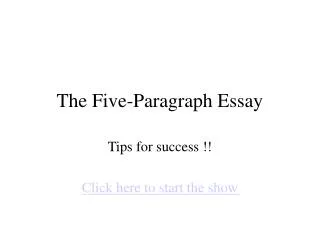
The Five-Paragraph Essay
The Five-Paragraph Essay. Tips for success !! Click here to start the show. The Five-Paragraph Essay. Is a basic essay format which every student should know Has several formally-designated parts May be subjective or objective in nature Has a clear, single focus on an idea or subject
704 views • 14 slides

The five paragraph essay
Expository Essay. The five paragraph essay. The introduction should consist of 4 sentences: The hook The statement of situation Theme Thesis. Hook. The first sentence of an essay; should capture the reader’s attention.
419 views • 21 slides

The Five-Paragraph Essay. You have to know the rules…. …in order to break the rules. Mrs. Griz English 9. Why do we have to learn how to write a five-paragraph essay anyway?. MCAS SAT English10 English11 English12 College Entrance Essays. Quotes :.
611 views • 19 slides

The Five Paragraph Essay
The Five Paragraph Essay. 5 Paragraph Essay. Basic Structure Paragraph 1: Introduction -- Hook and Thesis Paragraphs 2-4: Body Paragraphs -- Topic Sentences and Supporting Details Paragraph 5: Conclusion -- Restate Thesis. Paragraph One: Introduction.
435 views • 13 slides

The Writing Process and Five Paragraph Essay
The Writing Process and Five Paragraph Essay. Brainstorming.
218 views • 9 slides
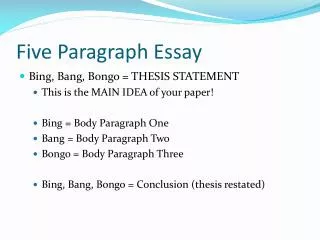
Five Paragraph Essay. Bing, Bang, Bongo = THESIS STATEMENT This is the MAIN IDEA of your paper! Bing = Body Paragraph One Bang = Body Paragraph Two Bongo = Body Paragraph Three Bing, Bang, Bongo = Conclusion (thesis restated). INTRODUCTION . Start with an attention grabber A quote
274 views • 6 slides

Writing a five paragraph argumentative essay
Writing a five paragraph argumentative essay. What are the key components of an Essay ?. Introduction 3 Body Paragraphs Conclusion . What are the key components of an Introduction.
232 views • 12 slides

Five-Paragraph Essay
INTRODUCTION Hook Thesis Map. Five-Paragraph Essay. BODY PARAGRAPH 1 Topic Sentence Evidence Commentary Evidence Commentary Evidence Commentary Transition. Five-Paragraph Essay. CONCLUSION Map Thesis Hook. Thesis Statements. W ho, W here, V ivid V erb, t hat, T heme.
507 views • 37 slides
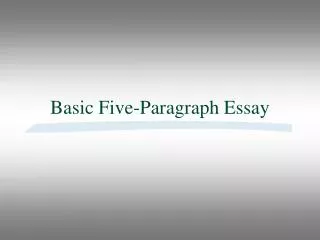
Basic Five-Paragraph Essay
Basic Five-Paragraph Essay. A five-paragraph essay should have the following basic format:. I. Introduction A. Background info/Lead/Attention-Getter B. Thesis sentence (including 3 specific points) II. Topic sentence for 1st body paragraph A. Point one
221 views • 7 slides

Five Paragraph Essay. 1 st Paragraph : Introduction, thesis and supporting details. 2 nd Paragraph : First claim and supporting details. 3 rd Paragraph : Second claim and supporting details. 4 th Paragraph : Third claim and supporting details.
521 views • 2 slides
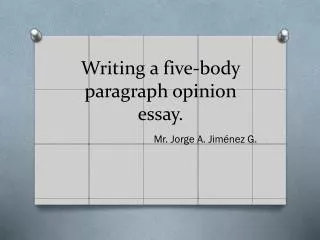
Writing a five-body paragraph opinion essay .
Writing a five-body paragraph opinion essay . Mr. Jorge A. Jiménez G. Persuasive Essays.
439 views • 12 slides
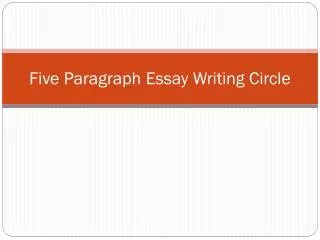
Five Paragraph Essay Writing Circle
Five Paragraph Essay Writing Circle. Writer’s jobs before the circle . . . . Highlight your thesis statement Highlight the evidence/examples that you have provided to support the assertions you’ve made in your body paragraphs
184 views • 11 slides

Five Paragraph Essay. “The Lottery” Model Paragraph. Topic Sentence. TOPs (Topic Sentence) is the main idea of the paragraph (not a detail) The TOPs is one sentence in length It is the first sentence of a body paragraph
202 views • 9 slides
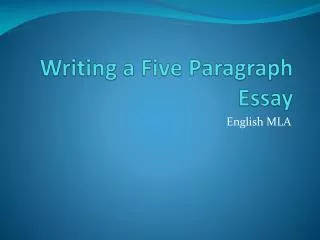
Writing a Five Paragraph Essay
Writing a Five Paragraph Essay. English MLA. Research Your Topic. We watched the movie “Jaws” What can you tell me about this movie in general?. General Facts About Our Topic. Movie came out in 1975 Based on the novel “Jaws” by Peter Benchley Genre: Horror/thriller
485 views • 20 slides

162 views • 8 slides
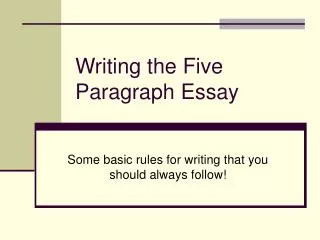
Writing the Five Paragraph Essay
Writing the Five Paragraph Essay. Some basic rules for writing that you should always follow!. The Topic. When you read an essay question or prompt, first determine what it is you are being asked to do.
306 views • 12 slides

Writing a Five-Paragraph Essay. Skit. Person 1: Hey! Did you see the game last night? Person 2: What game?
223 views • 15 slides

This presentation shows simple steps on how to write your Five Paragraph essay successfully. Also you can find more information in this article https://essay-academy.com/account/blog/a-five-paragraph-essay
308 views • 9 slides

The Five-Paragraph Essay. (Or, The Multi-Paragraph Essay). (. A five-paragraph essay should have the following basic format:. I. Introduction A. Background info B. Thesis sentence (including 3 specific points) II. Topic sentence for 1st body paragraph A. Point one
118 views • 9 slides
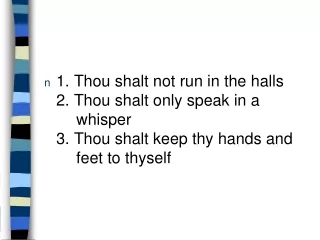
1. Thou shalt not run in the halls 2. Thou shalt only speak in a whisper 3. Thou shalt keep thy hands and feet to thyself. The Five Paragraph Essay. A Framework for Writing Essays in History. C’est Moi!. I enjoy writing essays. I consider myself a decent writer.
422 views • 38 slides
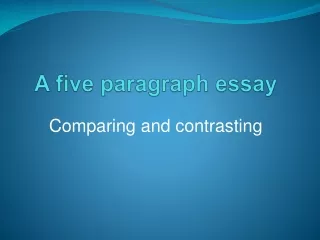
A five paragraph essay
A five paragraph essay. Comparing and contrasting. First steps. Getting the reader ’ s attention If you want someone to care about your opinion, give them something interesting to read! Look at the title you have chosen, how can you grab the reader ’ s attention?
78 views • 7 slides

IMAGES
VIDEO
COMMENTS
Conclusion Paragraph Outline: 1) Use a transition word or phrase (In conclusion, etc.) and then r estate your thesis in different words. 2) Review your main reasons you stated in the body paragraphs. 1-2 sentences. 3) Clincher statement- this could be a restatement of your attention getter in different words.
5 Paragraph Essay. 5 Paragraph Essay • Introduction • Body Paragraph #1 • Body Paragraph #2 • Body Paragraph #3 • Conclusion. 5 Paragraph Essay • 5 paragraph essay is a formulaic way of writing that can help beginning writers better organize their thoughts. • As students move up through higher grades, this format can be used as the framework for more diverse writing.
There is an Outline worksheet on the back of this page to help you start planning the content, order and organization of your essay. Paragraph 1: Introduction -- If possible, open with an attention-getting device to interest the reader (perhaps a quote or question). Introduce the topic of your essay in general, and present some context for this ...
Start with an introduction that hooks the reader, make your points and back each one up with its own paragraph, and then round it all out with a conclusion. Use transition language like, "next" and "finally" between your supporting paragraphs to indicate that you're moving to a new point. A basic five paragraph essay outline will help ...
This PowerPoint was created with Tahoma font, which is standard in Microsoft (PowerPoint). This PowerPoint can certainly teach your students to write a five paragraph essay but I highly recommend that you also check out my Five Paragraph Essay Instructional Unit. I modeled the PowerPoint after my instructional unit, so the two complement each ...
Students can use the following steps to write a standard essay on any given topic. First, choose a topic, or ask your students to choose their topic, then allow them to form a basic five-paragraph by following these steps: Decide on your basic thesis, your idea of a topic to discuss. Decide on three pieces of supporting evidence you will use to ...
The Five-Paragraph Essay. The Five-Paragraph Essay. (Or, The Multi-Paragraph Essay). (. A five-paragraph essay should have the following basic format:. I. Introduction A. Background info B. Thesis sentence (including 3 specific points) II. Topic sentence for 1st body paragraph A. Point one. 118 views • 9 slides
The 5 paragraph Essay. The 5 paragraph Essay. 5 paragraph essay . Written to inform, persuade, and demonstrate knowledge. Intro Paragraph1 Paragraph 2 Paragraph 3 Conclusion. Thesis Statement. The main point of your essay Is the central theme of your essay Everything you say ties back to your thesis statement. 233 views • 9 slides
49. $4.50. Zip. You can teach your students (even from a distance) how to write a 5-paragraph essay that has an introduction, 3 body paragraphs, and a conclusion by using this interactive and in-depth PowerPoint that is 86 slides long. A PowerPoint companion handout is included so that students can follow along and.
The five-paragraph essay, outlined below in Figure 3.1 is probably what you're used to: the introduction starts general and gradually narrows to a thesis, which readers expect to find at the very end of that paragraph. In this format, the thesis uses that magic number of three: three reasons why a statement is true.
An 86-slide PowerPoint that is interactive and thoroughly explains 5-paragraph essays. 5-Paragraph essay graphic organizers (multiple designs to choose from and differentiated) A 5-paragraph sample essay that you can copy onto chart paper as well as pass out to students. Anchor chart pieces that can be printed and glued to chart paper.
In order to gain expertise knowledge in essay. writing every student must initially learn. properly to write a 5 paragraph essay within a. specified time period. Here is the basic format. to construct a five-paragraph essay. 4. Basic Format of a Five-Paragraph Essay. First Paragraph Introduction to the main topic.
PARAGRAPH 1 introduces the thesis and directs. the reader to the three main supporting. subtopics. PARAGRAPHS 2 4 individually restates the. subtopics and provide supporting information. PARAGRAPH 5 restates the main thesis idea and. reminds the reader of the three main supporting. ideas that were developed. 3.
Expository Essay The five paragraph essay. The introduction should consist of 4 sentences: • The hook • The statement of situation • Theme • Thesis. Hook • The first sentence of an essay; should capture the reader's attention. • Santiago stares silently as the sharks devour his greatest accomplishment.
5 Paragraph Essay. 5 Paragraph Essay • Introduction • Body Paragraph #1 • Body Paragraph #2 • Body Paragraph #3 • Conclusion. 5 Paragraph Essay • 5 paragraph essay is a formulaic way of writing that can help beginning writers better organize their thoughts. • As students move up through higher grades, this format can be used as the framework for more diverse writing.
Writing aFive-Paragraph Essay Writing essays or themes requires the author to follow a predictable format. The Completed Essay • Four identifiable parts • Title • Introductory Paragraph • Body or Detail Paragraphs (3+) • Concluding Paragraph. The Working Essay • The author will be similar to a chef creating a delicious Italian grinder.
Title: The Five-Paragraph Essay 1 The Bing, The Bang, and The Bongo. The Five-Paragraph Essay; 2 Warm Up 100 Word Essay. One day, you are out in your yard when the next-door neighbor's garden gnome suddenly walks over and starts telling you about "what is really going on." Write this scene. Or choose your own topic to write about. 3